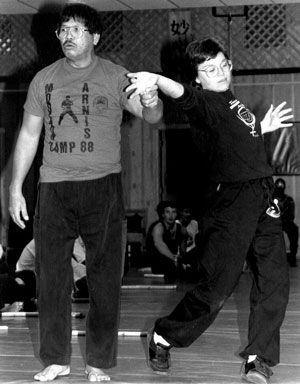Table of Contents
Personal Journey
After keeping my Sparring Journal the last few months, I realized I probably should and definitely want to make a few entries providing additional context around my training and my FMA Journey. Since that does not really fit with the specific purpose of the sparring journal, I have created this page.
A Little History: Before I Trained
As a child of the late 80s, martial arts have very much been part of my childhood zeitgeist. I grew up watching Power Rangers and Jackie Chan. The Karate Kid was a stop-channel-surfing-and-watch kind of movie. I saw The Matrix in a theaters at the seminal age of 11.
After years of reflection, if I'm going to be perfectly honest, I do know exactly where my love of and interest in martial arts originates. As a child I faced physical and emotional abuse. More than anything I was made to feel out of control of my life. What appealed to me about martial arts was the physical empowerment. A skilled martial artist did not have to smash the face in of every opponent, either. His reputation as a bad-ass was enough to make the peons in his life let him be his own person. A skilled martial artist had the respect of others, even if there were other points of contention or personality conflicts–a good fighter was a good fighter.
Additionally, martial arts are as cerebral (or at least in the 90s portrayed as such) as they are physical. As much as anything, martial arts require a strong mental discipline and focus–things that I (and still do) admired and somehow made it all the more tangible and thus obtainable. I knew as a kid I wouldn't be a star baseball player, but physical prowess plays only a small part in being a martial artist.
Retrospectively, I know now the vast majority of martial arts is repetition to build up as close to instantaneous response as possible. Mental discipline is absolutely a part, but not to the degree my younger self believed. Meditation will not make you into an unstoppable bad-ass. Years of practicing combos, sparring, and techniques will make you slightly less likely to get your butt kicked against a large, fast opponent.
So while my interest was piqued, I could not muster the courage to attend a class. I had (again, due to the abuse I faced) a severe performance anxiety and deeply seeded fear of failure. Basically, if I couldn't instantly be good at something, I would not even try. I loved and admired martial arts, but it was not until after moving out of my parents' home that I was able to muster the courage to start taking a class.
A Little History: The Start of Training
A few months after moving out of my parents' home, at nineteen years of age I started taking a Modern Arnis class at a nearby martial arts school. Safe Skills was primarily a karate dojo, but still had a two-hour Modern Arnis class on Sundays.
Taking the Next Steps
At Safe Skills, we lined up in order from most experienced to least experience. I started right at the farthest end and stayed there for years. People would join, train for a few months, and leave, putting me back to the end. Attendance began to wan and eventually the Sunday class was cancelled. It was moved to Wednesday evenings.
After a break from training due to illness, I returned to class on Wednesdays, with a new-to-me set of students. I went to my usual, end of the line spot and Sensei immediately corrected me: “You're down here,” she said, pointing to the front of the line. And just like that I went from my schools least experienced Arnis student, to the most experienced.
I became Sensei's go-to uke; helping show drills and assisting other students. It was at this point I realized I actually had made significant progression since when I first started. I did know something. I did have some finesse. I also realized, if I wanted to continue to improve I'd have to do one or both of two things: teaching and sparring.
I've taught a few individuals one on one a few of the basics. Assisting in class also has gotten me more comfortable teaching.
Sparring was another challenge. I had never actually sparred before. We had done what was essentially slow-sparring (light or no contact). I traded sticks with a partner in empty-hand-vs-weapon drills, but I had never gone full contact before.
The search for sparring partners was surprisingly difficult. After weeks of looking leveraging social media and personal contacts, I found one person willing to go a few rounds with me. I held no delusions; I knew I would probably do poorly that first go against someone with fully resistive sparring experience. As can be attested by my sparring journal, I did.
But then I found the Triangle Sword Guild, who holds open sparring sessions on a regular weekly basis. I checked with Ben, the head instructor, if some cross-training would be possible. He readily welcomed me to come out. A month of sparring with TSG took me from a purely theoretical fighter to one with some practical mettle. More than anything, I'm pleased that Safe Skills training has been as top-notch as I believed it to be all these years. The skills I've been taught and have been practicing for nearly a decade really do work–it just takes some practice actually applying them to sharpen them to a useful state.
Sparring has corrected some bad habits I developed from years of drilling without sparring. Going up against weapons longer than mine has also helped me really focus on range, both the range of my weapon and the range of my opponent's. Again, sparring has sharpened my overall awareness–where my hands, weapon, feet, and body are in relation to one another. Sparring has made the feedback I've received in Arnis class all the more poignant–remove the pauses in your movements; anticipate what you're going to do next so you can already be moving into position; move your feet; do not over extend your reach.
The Closing of Safe Skills
After thirty-three years of operation, Safe Skills is closing it doors due to low attendance and rising operational costs.
Safe Skills did not push testing for ridiculous belt colors or follow popular MA trends to generate money and lure students in. Dues were on a monthly non-contract basis. Safe Skills operated with integrity and respect for its students, but that was not enough to sustain them, unfortunately.
What it means for me is something of a quandary. There's another Modern Arnis school in the area, but it's distance makes it unlikely for me to make it out every week. I have considered throwing in with Triangle Sword Guild more fully, but I do not want to take up a new art, but continue to grow in my current one.
I have concluded the best option for me is to start my own class. In the very least, finding a space and going out to it every week will keep me practicing, even if it's by myself. And if I can get other students to show up, I can train with them. As I stated before, teaching is definitely something I should be doing and is even part of my retirement plan–buying my own space to run a class. I might as well get started teaching now.
Sensei Beth with Modern Arnis founder Remy Presas

Thanks, Sensei Beth!
